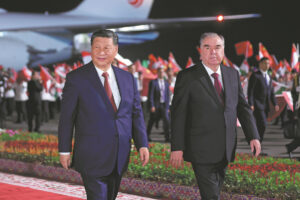- The central bank of China reduced a significant interest rate in an attempt to stimulate the falling economy.
- At the same time, economists are becoming increasingly optimistic about the outlook for the US economy until 2024.
China’s central bank reduced a significant interest rate to stimulate an economy grappling with a worsening decline in the real estate market and sluggish consumer spending.
Recent data revealed that housing prices in China experienced a consecutive monthly decrease in July. Additionally, industrial production and retail sales figures fell short of expectations. Following a substantial rate reduction on Tuesday, the People’s Bank of China intensified its endeavors later in the week to support the struggling yuan currency.
Global economy outlook
At the same time, economists are becoming increasingly optimistic about the outlook for the US economy until 2024 unlike China. Conversely, China continued to receive discouraging updates this week, with data indicating more indications of weakening growth. Moreover, mounting evidence shows that the longstanding property crisis, which has burdened the economy for years, might extend its impact on the financial sector.
In Japan, there was a significant development as the growth in service-related prices reached 2% in July, a milestone not achieved in 30 years. This awaited advancement is noteworthy for the central bank as it awaits solid evidence of sustainable inflation before establishing a pathway toward policy normalization.
In the second quarter of this year, Malaysia’s economic growth fell short of expectations, expanding at its slowest rate in almost two years. That was attributed to weakened global demand and the impact of the El Niño weather pattern. As Southeast Asian nations heavily reliant on trade face external challenges, they are increasingly focused on bolstering domestic consumption. However, the outcomes of this effort have been varied.
Taiwan’s economy is anticipated to achieve growth of less than 2% this year, as per the latest government projection. That underscores the notion that the electronics industry’s global downturn might endure longer than initially anticipated.
Economists are foreseeing a more robust US economy in the coming year, coupled with a smaller increase in unemployment. These expectations support the idea that the Federal Reserve will maintain higher interest rates for an extended period.
In July, US retail sales exceeded predictions, indicating that consumers still possess the means to uphold the ongoing economic expansion. Commerce Department data released on Tuesday indicated a 0.7% rise in the value of retail purchases for July, following upward revisions for the preceding two months.
Last week, the 30-year fixed mortgage rate surged to 7.16%, matching levels last seen in 2001. This increase has dampened both home sales and refinancing activities. Notably, a gauge of mortgage applications for home purchases reached its second-lowest point since 1995.
Interest hikes cuts are happening globally
In the UK, inflation persisted above anticipated levels last month, driven by increased expenses for travel and holidays. That further strengthens the argument for the Bank of England to implement another interest rate hike. The Consumer Prices Index climbed by 6.8% in July, surpassing the economist-projected rate of 6.7%. That marked the fifth instance in six months where the figures exceeded expectations on the positive side. Notably, inflation remains more than three times higher than the Bank of England’s targeted 2%.
The shortage of skilled labor is worsening, which is impeding Germany’s productivity. A rising number of companies within Europe’s largest economy need more qualified personnel. Out of around 9,000 polled firms, over 43% reported experiencing a shortage of skilled workers in July. This figure increased from just over 42% in April. The record high, approaching 50%, was attained in July 2022.
Colombia’s economy contracted beyond initial estimates in the second quarter, intensifying expectations for upcoming interest rate reductions. With inflation-targeting policies across Latin America’s major economies, interest rate cuts are projected in the coming months due to a cooling of growth and inflation throughout the region.
Turkey’s inflation outlook is deteriorating due to a weakened currency. A significant survey by the country’s central bank reveals that analysts anticipate the swiftest projected price increases in more than twenty years.
In addition to China’s unexpected rate reduction, Uruguay implemented a larger-than-anticipated cut, while New Zealand maintained its rates. Russia’s central bank notably raised interest rates considerably and indicated the possibility of another increase in an emergency meeting aimed at stabilizing the national currency. Simultaneously, Norway escalated its deposit rate to its highest point since 2008.
Source : cryptopolitan.com











